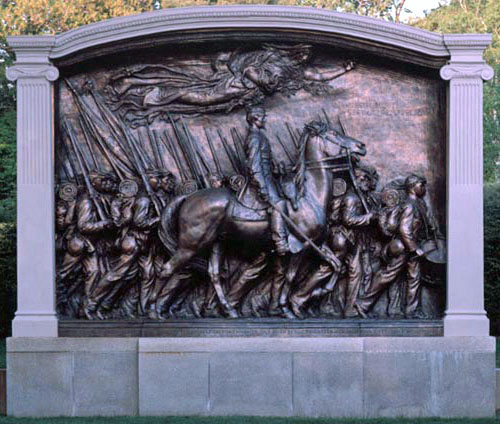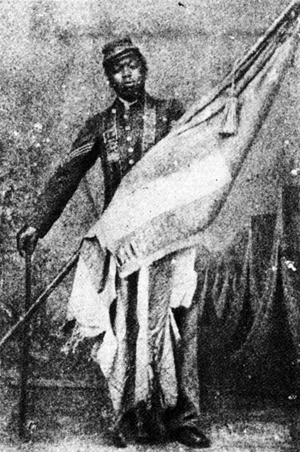 |
||
| Home | Our Mission | History | Members | Photographs | Events | Links | |
||
History |
||
|
||
The 54th Massachusetts Volunteer Infantry Regiment was an infantry regiment that saw extensive federal service in the Union Army during the American Civil War. The regiment was one of the first official black units in the United States armed forces. An earlier regiment of black freedmen, the 1st Rhode Island Regiment, had fought alongside George Washington in the Revolutionary War. |
||
The regiment was authorized in March 1863 by the Governor of Massachusetts, John A. Andrew. Commanded by Colonel Robert Gould Shaw, it sprang to life after the passage of the Emancipation Proclamation. Secretary of War Edwin M. Stanton decided white officers would be in charge of all "colored" units. Colonel Shaw was hand picked by Governor John Andrew. Governor Andrew also selected Norwood Penrose "Pen" Hallowell as the unit's second in command, a rank of Lieutenant Colonel. Like many officers of regiments of African-American troops, both Shaw and Hallowell were promoted several grades, both being captains at the time. The rest of the officers were evaluated by Shaw and Hallowell. Many of these officers were of abolitionist families and several were chosen by Governor Andrew himself. Lt. Col. Norwood Hallowell was joined by his younger brother Edward Needles Hallowell who was eventually appointed major in the regiment and would later command it after Shaw's death. Twenty-four of the twenty-nine officers were veterans but only six had been previously commissioned.
|
||
|
||
|
William Harvey Carney (February 29, 1840 – December 8, 1908) The regiment gained recognition on July 18, 1863, when it spearheaded an assault on Fort Wagner near Charleston, South Carolina. At this battle, Colonel Shaw was killed, along with one-hundred and sixteen of his men. Another hundred and fifty-six were wounded or captured. The total casualties of 272 would be the highest total for the 54th in a single engagement during the war. Although the Union was not able to take and hold the fort, the 54th was widely acclaimed for its valor, and the event helped encourage the further enlistment and mobilization of African-American troops, a key development that President Abraham Lincoln once noted as helping to secure the final victory. Sergeant William Harvey Carney was the first African American to be awarded the Congressional Medal of Honor. Although he was not presented with the honor until nearly 37 years after his acts of bravery. Carney rescued the U.S. flag as the flag bearer fell, carrying the flag to the enemy ramparts and back, and saying "Boys, the old flag never touched the ground!" While other African-Americans had since been granted the award, Carney's is the earliest action for which the Medal of Honor was awarded to an African-American. Carney was born a slave in Norfolk, Virginia, but escaped to Massachusetts like his father through the Underground Railroad. They later bought the rest of the family out of slavery. In later life, Carney was a postal employee and popular speaker at patriotic events. He died in Boston, Massachusetts, and is buried in the family plot at Oak Grove Cemetery in New Bedford, Massachusetts. Engraved on his stone monument is a gold image of the Medal of Honor. |
|
The Robert Gould Shaw and Massachusetts 54th Regiment Memorial, located across Beacon Street from the State House, serves as a reminder of the heavy cost paid by individuals and families during the Civil War. In particular, it serves as a memorial to the group of men who were among the first African Americans to fight in that war. Augustus Saint-Gaudens took nearly fourteen years to complete this high-relief bronze monument, which celebrates the valor and sacrifices of the Massachusetts 54th. Saint-Gaudens was one of the premier artists of his day. He grew up in New York and Boston, but received formal training at the Ecole des Beaux-Arts Paris. In New York, forty men were hired to serve as models for the soldiers’ faces. Colonel Shaw is shown on horseback and three rows of infantry men march behind. This scene depicts the 54th Regiment marching down Beacon Street on May 28, 1863 as they left Boston to head south. The monument was paid for by private donations and was unveiled in a ceremony on May 31, 1897. In 1982, 64 names of known soldiers who died at the Battle of Fort Wagner were inscribed on the back of the monument. (National Parks Service) |
 |
|
© 2009 This 54th Massachusetts Company A website is designed, produced and maintained by Michael Coblyn. |
||


